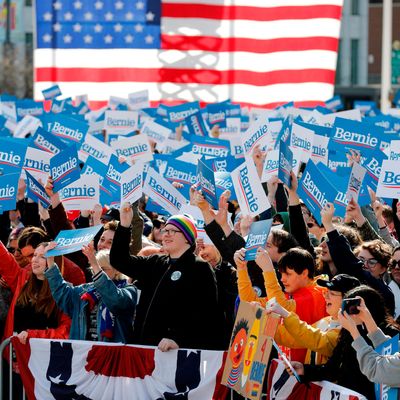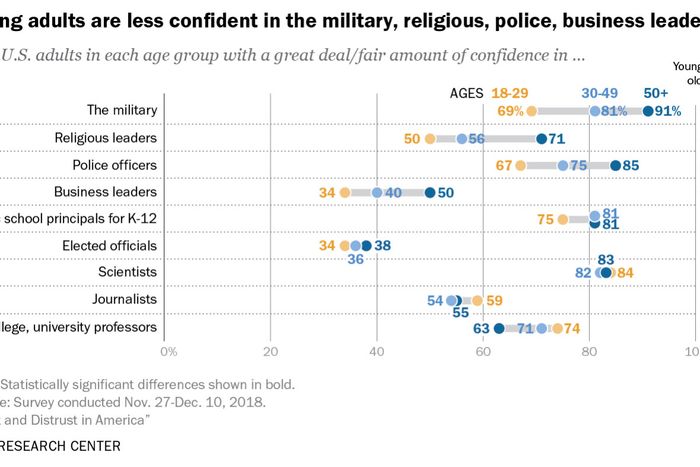
Over the course of the 2020 primary race, Bernie Sanders and his sympathizers have derided Joe Biden (with some justification) as a warmonger, an ally to segregationists, a nepotist, and a corporate shill whose “broken brain” was sure to cost Democrats the 2020 election.
Now, for the second straight week, Biden has handed his intraparty adversaries a string of bruising defeats. As of this writing, the western states of Washington, Idaho, and North Dakota have yet to report results. But the former vice-president has already defeated Sanders in his 2016 stronghold of Michigan and trounced the Vermont senator in Missouri and Mississippi. The scale of Biden’s victories in the South and Midwest ensure that he will emerge from Tuesday night’s contests with a larger delegate lead than he entered with, no matter what transpires out west.
Given the ferocity of the left’s criticism — and the magnitude of his recent victories over its standard-bearer — Biden might be tempted to write off his progressive detractors as so many “lying dog-faced pony soldiers” once this primary is over. But if he wants to win in November — and would like the Democratic Party to thrive thereafter — Uncle Joe will need to negotiate a truce with Bernie’s immoderate rebels. (To be sure, blue America’s civil war is not quite finished. But barring a medical emergency or criminal indictment, it is difficult to see how Biden does not secure the nomination in Milwaukee.)
Some in Biden’s camp may see little need to make accommodations to the Bernard brethren. After all, the former vice-president is already running well to the left of both Barack Obama and Hillary Clinton. His campaign platform features a $1.7 trillion climate plan, $15 minimum wage, deportation moratorium, strong public option for health insurance, and a robust package of pro-worker labor-law reforms. To the extent that Sanders supporters are reachable, shouldn’t this historically progressive agenda — combined with the specter of a second Trump term — be sufficient to keep them beneath blue America’s big tent? Why cater to the left when you can pivot to the center? The former has fewer votes to give and no real place to go, anyway.
But such reasoning is misguided in multiple respects. First, Sanders’s faction is not the same old minority of staunch progressives that have been with the Democrats since time immemorial. It is a coalition of the ascendant. Throughout the 2020 campaign, Sanders has boasted the lion’s share of the millennial and zoomer generations’ support, while Biden got by with a minuscule fraction: As of late January, national polls were putting Biden’s support among voters under 35 within their margin of error. And although the Democratic front-runner has gained some of the younger vote as the field has narrowed, exit polls from Tuesday night’s races once again confirmed that Biden’s crusade against “malarkey” (and/or single-payer health care) does not resonate with the young folk. Even as he lost Michigan and Missouri by hefty margins Tuesday night, Bernie Sanders won voters under 30 in those states by 76 points and 57 points respectively, according to exit polls.
To maximize his odds of victory in November, Biden will need to improve his standing with younger, progressive voters. Given Trump’s structural advantage in the Electoral College, Democrats can’t afford to take any votes for granted. To whatever extent Biden can earn the enthusiasm of this block — whose turnout rates tend to be variable and identification with the Democratic Party much weaker than older voters with similar ideological inclinations — he would be wise to do so.
Ultimately though, winning over young Sanders supporters may be less important for prevailing in November than it is for fortifying the Democratic coalition in the years and decades to come. The millennial and zoomer generations aren’t just more progressive — and less partisan — than their predecessors. They also evince far lower levels of social trust: In a Pew Research survey released last year, 73 percent of Americans between the ages of 18 and 29 said that “most of the time, people just look out for themselves,” while 71 percent claimed that “most people would try to take advantage of you if they got the chance,” and 60 percent contended that “most people cannot be trusted.” Among Americans over 65 — the most conservative cohort in the U.S. — those figures are 48, 39, and 29, respectively. Meanwhile, younger Americans also espoused far less faith in elected officials than their elders:
This should be a source of significant concern for Democrats. Ideologically, the rising generations are natural constituents for the party — if they develop the habit of voting and the inclination to accept that the two major parties are their only options on a national level. But low social trust is associated with both third-party voting and abstention from the electoral process. The elements of Bernie Sanders’s political style that moderate Democrats find most alienating — its unsparing, broad-brushed indictment of all partisan, media, and economic Establishments that resist the political revolution — is no small part of what enables him to resonate with younger voters, including ones whom other Democrats have never been able to reach.
By contrast, it’s difficult to imagine a worse standard-bearer for young Democrats with anti-Establishment leanings than Joseph R. Biden Jr., a fixture of national politics for more than 50 years. In that time, he has been an active participant in damn near every major policy failure that’s plagued the millennial generation’s existence, from mass incarceration to the Iraq War to the student-debt crisis. This year, he has centered his primary campaign on nostalgia for a past that never existed and that Americans under 35 are too young to misremember. Biden has even allowed himself to be caught on tape saying, “The younger generation now tells me how tough things are — give me a break. No, no, I have no empathy for it, give me a break.”
All of which makes Biden a dangerous nominee for the long-term health of the Democratic Party. But here we (apparently) are. There are some young voters that Biden is never going to be able to reach. But he has a responsibility to do everything he can to make as many as possible feel represented by his campaign.
The lowest bar that Biden can clear would be to adopt every item on the Sanders platform that is unambiguously popular with the general public. Pundits who posit an irreconcilable tension between guarding one’s left flank and appealing to swing voters ignore a basic fact: Most voters are ideologically heterodox and hold a diverse array of left-wing and right-wing policy positions. For this reason, Biden has plenty of room to align himself more closely with Sanders while expanding his appeal among self-professed moderates.
Marijuana legalization is the biggest no-brainer. Biden was alone among 2020 Democrats in refusing to endorse legal weed, and not without reason: All his co-partisans recognized that the upsides of 420-friendliness are high, and the downsides are mellow. A Pew Research survey released last year found that 67 percent of Americans believe “the use of marijuana should be made legal.” A recent Gallup poll put that figure at (a statistically identical) 66 percent. Critically, weed legalization isn’t just popular with the public as a whole but also with key Electoral College constituencies. In Pew’s survey, non-college-educated voters — who are overrepresented in battleground states — were even more likely to support legalization than college-educated ones, with only 31 percent of working-class Americans backing Biden’s anti-legalization stance. In fact, Data for Progress’s modeling of state-based support for legal weed found a majority of Trump voters in 49 U.S. states back an end to marijuana prohibition.
Other overwhelmingly popular items on Sanders’s agenda include requiring large corporations to put workers on their corporate boards, capping credit-card interest rates at 15 percent, imposing a wealth tax on the fortunes of billionaires, and making public colleges and universities tuition free. (Polling support for the last proposal is not quite as consistently high as it is for the preceding ones, but free college is also uniquely salient to the younger Bernie supporters whom Biden needs to reach).
All this said, campaign website promises are easy to write off. Highly engaged voters know that Biden will need improbable levels of Senate support to make good on his policy promises, while mere experience has taught low-engagement voters to discount the pledges of politicians. To give these concessions some heft, Biden will need to put personnel where his policy is. He should aim to bring as many of Sanders staffers onboard his campaign as possible, including the most sharp-elbowed among them. More importantly, he must pick a running mate who is better aligned with the future of his party than himself.
Biden’s advanced age and the closely divided partisan breakdown of the Senate complicate the veepstakes calculus. Whoever Biden taps will need to be a credible manager of the federal government from day one, and if Democrats wish to retain the distant hope of actually governing in 2021, that person’s elevation must not cost the party a Senate seat. Elizabeth Warren fits the first criterion. But thanks to Republican Charlie Baker’s claim to the Massachusetts governor’s mansion, she may not meet the second. Under the Bay State’s laws, Baker would get to appoint an interim senator until a special election could be convened, potentially leaving Democrats short a Senate vote for the first 160 days of a Biden presidency. Warren could potentially cut that window short by preemptively resigning from the Senate before Election Day. But even in that scenario, Baker’s handpicked Republican would enjoy the benefits of incumbency and a GOP base energized by electoral defeat in early 2021. For similar reasons, it might be unwise to remove Wisconsin’s progressive senator Tammy Baldwin from the upper chamber. Thus, Democratic House members like the Sanders-aligned Ro Khanna or “squad” member Ayanna Pressley might be more prudent selections, even if their relative inexperience raises concerns about their readiness for high office.
Regardless, Biden must use his choice of running mate to mend his party’s generational fracture. Fortunately, there’s reason to believe he understands this: In 2016, Biden reportedly encouraged Hillary Clinton to name Elizabeth Warren as her running mate, so as to guard her left flank.
In sum, Biden needs to make millenials and zoomers feel at home in blue America — otherwise, Democrats could be headed for another long spell in the wilderness.

































